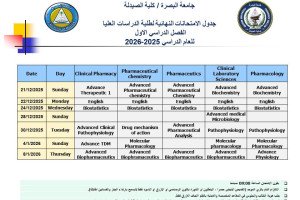
The Clinical Laboratory Sciences department of the College of Pharmacy at the University of Basrah organized a panel discussion on (Test Dimer-D) analysis, with the participation of researchers and specialists.
The seminar included a lecture given by assistant teacher Amal Malik, which included a detailed explanation about (Test Dimer-D), a blood analysis that is used to help rule out a blood clot or to help diagnose conditions related to blood clotting. The di-dimer is part of the fibrin protein, which is a protein that has a role in the clotting process
Indications for a Dimer test: A Dimer-D test may be needed if the patient has symptoms of a blood clotting disorder, such as deep vein thrombosis or pulmonary embolism. Where the symptoms of DVT include the following: leg pain, leg swelling, redness or red streaks on the legs. As for pulmonary embolism, its symptoms include the following: difficulty breathing, coughing, chest pain, rapid heartbeat.
If the Dimer D test is negative, a negative Dimer test (the level of Dimer in the blood is less than the specified threshold) indicates that there is likely to be no thrombosis (clot).
If a positive D Dimer test is positive, a positive D Dimer test can confirm that a person has a deep vessel thrombosis or pulmonary embolism. However, higher than normal levels of Dimer D in the blood indicates that more diagnostic procedures are needed (eg: ultrasound, CT angiography).








